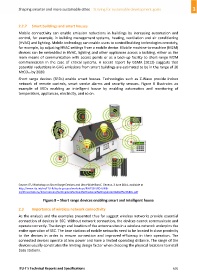Page 611 - Shaping smarter and more sustainable cities - Striving for sustainable development goals
P. 611
2.2.7 Smart buildings and smart houses
Mobile connectivity can enable emission reductions in buildings by increasing automation and
control, for example, in building management systems, heating, ventilation and air conditioning
(HVAC) and lighting. Mobile technology can enable users to control building technologies remotely,
for example, by adjusting HVAC settings from a mobile device. Mobile machine‐to‐machine (M2M)
devices can be embedded in HVAC, lighting and other appliances across a building, either as the
main means of communication with access points or as a back‐up facility to short‐range M2M
communication in the case of critical systems. A recent report by GSMA (2012) suggests that
potential reductions in GHG emissions from smart buildings are estimated to be in the range of 30
MtCO2e by 2020.
Short range devices (SRDs) enable smart houses. Technologies such as Z‐Wave provide indoor
network of remote controls, smart smoke alarms and security sensors. Figure 8 illustrates an
example of SRDs enabling an intelligent house by enabling automation and monitoring of
temperature, appliances, electricity, and so on.
Source: ITU Workshop on Short Range Devices and Ultra Wide Band’, Geneva, 3 June 2014, available at
http://www.itu.int/en/ITU‐R/study‐groups/workshops/RWP1B‐SRD‐UWB‐
14/Presentations/International,%20regional%20and%20national%20regulation%20of%20SRDs.pdf
Figure 8 – Short range devices enabling smart and intelligent house
2.3 Importance of wireless network connectivity
As the analysis and the examples presented thus far suggest wireless networks provide essential
connection of devices in SSC. Without network connection, the devices cannot communicate and
operate correctly. The design and location of the antenna sites in a wireless network underpins the
entire operation of SSC. The base stations of mobile networks need to be located in close proximity
to the devices in order to ensure connection and improved efficiency in their operation. The
connected devices operate at low power and have a limited operating distance. The range of the
devices usually constitutes the limiting design factor when choosing the physical locations to install
base stations.
ITU‐T's Technical Reports and Specifications 601

